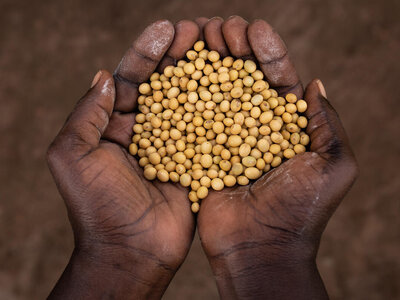Uganda
- 20.3%
- of people live below the poverty line
- 26%
- of children under 5 are stunted
- 45.9 million
- population
A land-locked country in East Africa, Uganda’s growth trajectory is vulnerable to multiple risks.
Uganda hosts Africa’s largest number of refugees. There are over 1.8 million refugees and asylum seekers from Burundi, the Democratic Republic of the Congo, Rwanda, Somalia, South Sudan, Sudan and other countries.
Despite Uganda’s progressive refugee policy providing land and freedom of movement, refugees continue to face significant livelihood, food security and economic constraints.
A volatile geopolitical environment could weigh on investment and exports, while the increasing frequency of droughts and floods heightens the vulnerability of Uganda’s smallholder farmers.
Uganda is ranked 159 out of 193 countries on the Human Development Index, according to the Human Development Report 2023. Despite its agricultural potential and significant exports, Uganda’s food insecurity levels remain classified as ”serious” by the 2024 Global Hunger Index. This poses further challenges to the country’s ability to achieve Sustainable Development Goal 2 on Zero Hunger.
According to the 2022 Uganda Demographic and Health Survey, around one in four children in Uganda are stunted (too short for their age) – a sign of chronic malnutrition. Poor-quality diets are creating health crises, undermining human capital development and jeopardising economic prosperity.
While the country has made some gains in reducing malnutrition, the situation remains concerning – particularly in refugee reception centres and in the semi-arid region of Karamoja.
What the World Food Programme is doing in Uganda
-
Crisis response
-
WFP provides cash and food assistance to refugees, starting with hot meals on arrival and continued support as they settle. However, due to funding shortfalls, WFP began reducing rations in March 2025. Refugees are now categorized: the most vulnerable receive 40 percent rations, moderately vulnerable 22 percent, and the least vulnerable are phased out of assistance. These are the lowest rations WFP provides in East Africa. In May 2025, WFP cut the number of refugees receiving aid from 1.6 million to 662,000, prioritizing those most at risk of food insecurity. These reductions are expected to worsen malnutrition and hunger. Despite challenges, WFP promotes self-reliance through a market-oriented model, supporting 50,000 households – 70 percent refugees and 30 percent host community members – to transition from aid dependency to meeting their own needs.
-
Climate action
-
School meals
-
Nutrition
-
Support to smallholder farmers
-
Social protection
-
Supply chain
Uganda news releases
Go to pagePartners and donors
Find out more about the state of food security in Uganda
Visit the food security analysis pageOperations in Uganda
Contacts
Office
Plot 142, Boazman Road, Mbuya Behind Mbuya Catholic Parish P.O Box 7159
Kampala
Uganda







